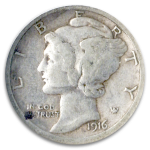Mercury Dime History and Key Dates
Posted on — 16 CommentsYou can purchase a Mercury dime for a few dollars. Yet, some of the most coveted key dates and mint marks are worth north of $25,000. Not bad for a dime.


Collectors actively pursue this stunning coin for the exceptional design created by Adolph A. Weinman. The metal content is 90% silver and 10% copper. The mints include Philadelphia, Denver and San Francisco.
Coin description:
Weinman’s design shows the head of a youthful Liberty in profile. She wears a cap that has wings, which were meant to represent “Liberty of Thought.” The public, however, misunderstood Weinman’s intent, believing her to be Mercury, who wore a cap and sandals with wings. (This would make sense since Mercury is the god of commerce.) Weinman’s monogram AW sits on the right of the Liberty’s neck.
The reverse features an unusual (for those used to modern coinage) design: a fasces depicting unity and strength, and an olive branch symbolizing peace.
1916 is a special year in the history of U.S. coinage.
Mercury dimes debuted in 1916 – a groundbreaking and unique year in the history of U.S. coinage. In 1916, the U.S. Mint created three new silver coins and it marked the first year – ever – that different designs were used on the dime quarter and half dollar.
As a coin group, Mercury dimes aren’t rare. An incredible 2.5 billion were struck from 1916 through 1945. Mercury dimes were last struck in 1945, when a new dime was created to feature Franklin D. Roosevelt, following his passing.
During the depths of the Great Depression, no mercury dimes were minted from years 1932-1933.
Today, rare coin collectors classify Mercury Dimes into “early dates” (1916-1931) and “late dates” (1934-1945) categories. Nearly all late dates are common and can be easily acquired.
There are several key dates for Mercury dimes.
Their scarcity increases their value into the thousands.
The 1916-D is perhaps the most famous and sought-after dimes. The original mintage was around 250,000. Today, 1916-D is very rare in mint state.
Other Mercury dime key dates include 1921 and 1921-D and 1942-1 and 1942 -1D. The latter key dates show “overdates” with the number “2” struck over the number “1.”
Blanchard recently had not one, but two 1916-D Mercury dimes. They are gone now. They sold fast.
Precious metals and rare coin prices are turning up. If you are interested in acquiring a 1916-D Mercury Dime or any other rare coin, we can help you do that. Blanchard has tremendous reach and respect within the rare coin industry.
Building sets of Mercury dimes can be an exciting and profitable goal.
Many collections of rare coin sets have sold for more than the total value of the individual coins. Coin investors typically follow one of two sets: “type” and “series.” A type set is comprised of all of those coins sharing a single specific characteristic such as a design, designer or denomination. A series include one coin from each date and mint of a particular type.
Other investing strategies include collecting by mint mark, by individual year, or first and last year of the issue of a coin.
16 thoughts on “Mercury Dime History and Key Dates”
Comments are closed.








Thank you. I found two Mercury dimes while Working retail for many years and buying them when seeing them. Still trying to learn the thins I need to know and look for. Thank you!
I used 2 get Mercury Dimes in my change when I was young & Buffalo Nickles!!! FUNFUNFUN…
I’m a collector
I have one 1918, 1924, 1926, 1940 – 1945 interested to know what they are worth
I have a mercury dime 1945 very fine 800.20
Could you show a Pic of the 1945 Dime? Thank you
I carry a mercury dime in my wallet. I think it’s represents America and freedom of thought. My brother got me cllecting coins in the 60s when we were kids. We worked in our fatheres hardware store and went thru the change drawers at closing. Steel pennies, indian head pennies, buffalo nickels, war nickels, silver half dollars etc. wow. The good old days
What is a war nickel
I found a 1916 D Mercury Dime in 1960. I sold it in 1961 for $72 to go to my Senior prom.
I remember someone having a hat with the band made up of Mercury dimes. Perfect for Las Vegas.
Need to know more about old coin
I have a 1945 D Mercury dime what is it worth
Hey Joseph:
Because there are so many variables that go into determining the value of rare coins, we always suggest you go in person to a reputable coin dealer in your area. They’ll be able to see the coin and give you more information.
I have a 1936 silver murcury dime in my wallet.I want to sell it . I dont know its worth.
Hi Nathan!
Because there are so many variables that go into determining the value of rare coins, we always suggest you go in person to a reputable coin dealer in your area. They’ll be able to see the coin and give you more information.
I have a lot of mercury dimes $ 9.20 worth